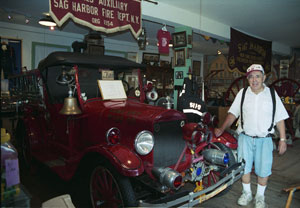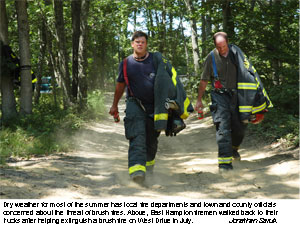Police Deliver 'Adam' And 'Eve'
Police Deliver 'Adam' And 'Eve'
Following a series of shoplifting arrests in East Hampton, detectives have been on the watch up Main Street and down Newtown Lane for suspicious-looking shoppers. On Saturday, they said, they caught yet another consumer taking a five-finger discount.
Louis Anthony Hillen, 44, of Fairview, N.J., reportedly told police he was headed to Montauk and decided to do some Christmas shopping along the way.
Detectives said they found him with $4,928 worth of ill-gotten booty, including a pair of three-and-a-half-foot-high sculptures valued at $2,000.
An Odd Bulge
The sculptures, elongated stainless-steel depictions of Adam and Eve by William King, were on display at the Arlene Bujese Gallery at 66 Newtown Lane.
Detectives staking out the street said they saw an odd bulge running down the back of Mr. Hillen's jacket and into the seat of his trousers, and decided to question him.
They said they found in his car a $139 pair of women's shoes from Coach Leather, a $119 brown suede vest from Mark, Fore and Strike, and a $195 gold-trimmed mirror from Rumrunners. All three shops are on Main Street.
Southampton Galleries
Four other items - a still life painting, an American Indian "dream catcher," and two sculptures tagged at $800 and $900 - are believed to have been taken from two shops in Southampton Town: Legendary Collectibles and the Sundance Gallery.
Mr. Hillen was charged with possession of stolen property and grand larceny, both felonies, as well as three counts of petty larceny. Bail was set at $750. Unable to raise it, he was sent to the county jail in Riverhead.
East Hampton Village Police Chief Glen Stonemetz said his colleagues in the Southampton Town Police Department were pursuing their own charges.
Local Men Charged
East Hampton Town police, meanwhile, charged three local men with cocaine and marijuana possession Saturday afternoon after a traffic stop on Montauk Highway in Montauk.
After clocking a 1990 Chrysler allegedly going 53 miles an hour in a 40-m.p.h. zone, police signaled the car to stop. As it pulled over, the police report stated, the driver, Rodney Spearmon of Whalebone Village, East Hampton, and his two passengers were observed making "overt movements" inside.
Two officers approaching the car allegedly noticed a strong odor of marijuana. The three were asked to step out of the vehicle.
Officers spotted a plastic bag and tinfoil on the floor of the car, both containing marijuana, police said. Searching further, police allegedly found a film canister containing more marijuana and a small amount of crack cocaine.
Police said an additional piece of crack was found in the possession of one of the passengers, 24-year-old Harold E. Breault of Hildreth Place, Springs.
Mr. Breault, Mr. Spearmon, and the third man, Emory J. Jones, 31, of Springs-Fireplace Road, East Hampton, were charged with seventh-degree criminal possession of a controlled substance and unlawful possession of a controlled substance, both misdemeanors.
Car Registration
Mr. Spearmon was additionally charged with operating a vehicle with a suspended registration. Police said a computer check revealed the car's registration was suspended in October.
Mr. Jones was later released on $500 bail; Mr. Breault was released on $350 bail, and Mr. Spearmon was released on his own recognizance.
Southampton Town police made a drug-related arrest of their own a week earlier, charging a Sag Harbor man Nov. 3 with crack possession and loitering.
Turnpike Arrest
An officer observed Robert Joseph Wilson, 33, of Dartmouth Road stop his car at Huntington Crossway around 7:20 p.m. and pick up a passenger, then drive north on the Bridgehampton-Sag Harbor Turnpike to the corner of Scuttlehole Road and stop again, letting the passenger out.
Police spoke with Mr. Wilson, who allegedly revealed he had been trying to buy crack and that he had a small quantity in his possession.
He was charged with seventh-degree criminal possession of a controlled substance and first-degree loitering, misdemeanors. Allegedly driving his car up the alleyway next to Estia restaurant and knocking over a street tree in the process earned an East Hampton man a criminal-mischief charge on Nov. 12.
The incident occurred around 1:30 a.m., police said. At around 4:30 that afternoon, 25-year-old Gene E. Lamonda of Springs-Fireplace Road turned himself in at town police headquarters on the advice of his lawyer. He was charged with fourth-degree criminal mischief, a misdemeanor, and released on his own recognizance to appear in court.
Angry Letters
Aggravated harassment was the charge for an East Hampton man accused of continuously harassing his estranged wife with angry letters.
Kathleen Bennett called police on Nov. 8 after finding one such letter in a plastic Ziploc bag under her car's windshield wiper. The letter, from her husband, Ronald L. Bennett of Joshua Edwards Court, contained "obscenities" directed at Ms. Bennett and her children, police said.
Ms. Bennett provided other letters to police, and an arrest warrant was issued. Police picked up Mr. Bennett on Friday and charged him with second-degree aggravated harassment, a misdemeanor.
He was released on his own recognizance.
Police Take A Trip
In other arrests, Jeffrey W. Krouse of Hampton Bays was picked up on Friday by village police in Harrison, N.Y., on a warrant issued by East Hampton Town Justice Court.
Mr. Krouse, 25, reportedly failed to make an appointment with his probation officer and then failed to answer the resulting charge in court last month. He was on probation after pleading guilty to a charge related to "the health and safety of the environment."
Justice Roger W. Walker released him on $300 bail, with a new court date next month.


